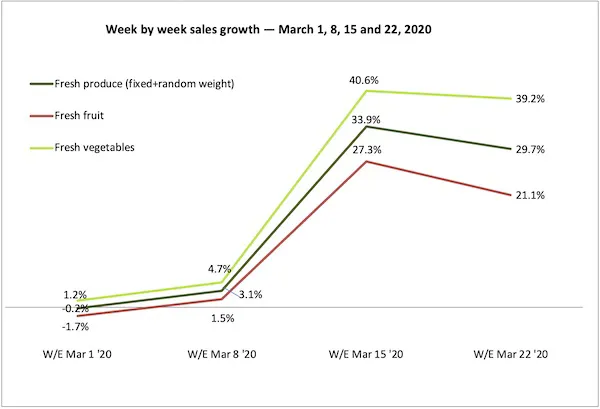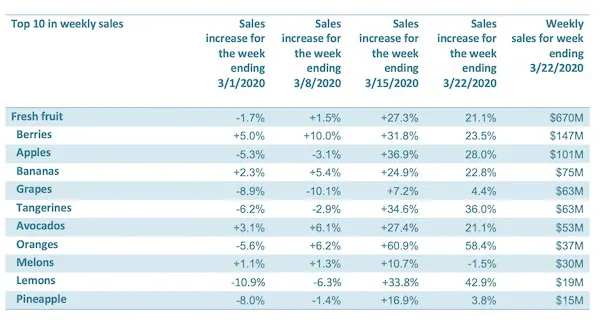Produce sales rose along with consumer anxiety levels. IRI found that 58% of consumers were extremely concerned about COVID-19 the week of March 22, up from 38% the prior week. 210 Analytics, IRI and PMA partnered up to understand the effect for produce. Produce continuing to move at unprecedented volumes regardless of where they are sold in the store:
- Fresh produce increased 29.7%
- Frozen, +111.4%
- Shelf-stable, +158.1%
Source: IRI, Total US, MULO, week ending March 22, 2020.
Fresh produce
Produce sales started to rise the second week of March, at +3.1%, followed by a 33.9% increase the week ending March 15. For the week ending March 22, IRI showed vegetables up 39.2% —adding $227 million versus the comparable week in 2019. Fruits gained 21.1% over the week of March 22 last year, which translated into an additional $116 million.

Source: IRI, Total US, MULO, week ending March 1, 8, 15 and 22, 2020.
Sales increases extended across fresh produce items. In absolute dollars, the biggest fresh produce winners for the week of March 22 were once more potatoes that gained $61 million, or +114.7% over the comparable week in 2019. “Berries were second, with a gain of $28 million, or 23.5%. Onions closed out the top three, with gains of $27 million, up 68.6%. Others that gained big were lettuce, apples, tomatoes, tangerines, bananas, oranges and carrots.
Fresh fruit
Fresh fruit sales saw a slightly bigger uptick during the week of March 22 than the week prior. On the fruit side, berries generated 22% of fruit sales, yet grew 23.5%. Similarly, apples generated more than 15% of all fruit sales and grew 28%.

Source: IRI, Total US, MULO, week ending March 1, 8, 15 and 22, 2020.
Fresh vegetables
On the fresh vegetable side, shoppers are stocking up on items with longer shelf life, in particular: potatoes, onions, carrots and squash.

Source: IRI, Total US, MULO, week ending March 1, 8, 15 and 22, 2020.
Fresh versus frozen and shelf-stable
Consumers continued to split their produce dollar three ways during the week of March 22. Jonna Parker, Team Lead, Fresh for IRI said: “Consumers remained in a stock-up mindset the week of March 22 and that drove high interest in frozen and shelf-stable fruit and vegetables. The share of total cross-store produce sales for shelf-stable is up from 10% during 2019 to 19% during the week ending March 22, 2020.”

Source: IRI, Total US, MULO, 2019 calendar year versus week ending March 22, 2020.
Canned vegetables once more saw the highest percentage gains, at 207.9%, followed by frozen vegetables and frozen fruit.

Source: IRI, Total US, MULO, week ending March 1, 8, 15 and 22, 2020.
For more information:
Anne-Marie Roerink
210 Analytics LLC
Tel: +1 (210) 651-2719
Email: [email protected]
www.210analytics.com
